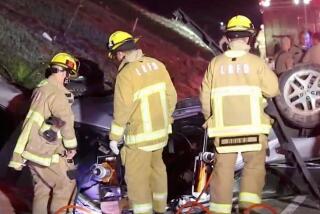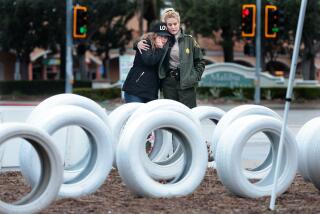Money Proposed to Fix Deadly Road Known as ‘Blood Alley’
- Share via
Soon after Amy Wisenor and her mother, Diana, moved to Palmdale three years ago, they noticed the crude wooden crosses, bouquets and other memorials to crash victims along the narrow highway officially called California 138.
“Mom and I even discussed it when we drove by, how sad it is for those families of people who died,” Wisenor said. “You never think it’s going to be you.”
But on a sunny Christmas Eve afternoon in 1998, as mother and daughter drove toward a family gathering, the unthinkable occurred. A teenage driver drifted across the road and hit their car head-on. Diana Wisenor, a 48-year-old vocational school teacher, died at the scene. Amy Wisenor suffered a concussion.
“It’s such a bad stretch of road,” said Wisenor, now 20 and living in Huntington Beach. “I feel angry that nothing was done about it.”
Now, however, Gov. Gray Davis has proposed spending $10 million toward widening the deadliest parts of the highway from one lane in each direction to two, and the Metropolitan Transportation Authority has proposed spending an additional $4 million on top of $57 million the agency has allocated toward improving the road. If all goes well, construction could begin by the summer of 2004 and end in fall 2005.
On maps, the road known as the Pearblossom Highway zigzags across the Antelope Valley south of Palmdale, traversing Littlerock and Llano and then heading into San Bernardino County. But homemade signs planted next to the road, considered one of California’s most dangerous, warn drivers that they are on “Deathtrap Highway” or “Blood Alley.”
Cutting through the high desert, California 138 is a thoroughfare for big-rig trucks and those traveling to Las Vegas. A surge in the population of northern Los Angeles County has also contributed increasing numbers of commuters.
Traffic along the highway “is getting worse every year,” said California Highway Patrol Officer Rusty Moore, who has lived in the Antelope Valley all his life and now patrols the area that includes California 138. “That road should have been widened years ago.”
According to the CHP, at least 22 people have died on the highway since March 1997. A Times computer analysis in February 2000 of accident data showed that 56 people died and 875 were injured on the 138 in the five previous years.
The main cause of accidents is drivers crossing into the opposing lane unintentionally or while trying to legally pass other cars.
Widening the road might reduce those numbers “quite a bit,” Moore said.
Officials will also consider putting dividers on some parts of the highway.
Other hazards include dips in the roadway that locals like Moore call “whoop-de-dos.” Drivers sometimes try to pass others while in a dip, even though their view of the horizon and oncoming traffic is blocked.
The proposed state funding is part of of the governor’s recently announced $892-million statewide spending plan. The MTA funding would be on top of $57 million the agency has already allocated to improving California 138, according to Renee Berlin, an agency director. The improvement project still needs approval from the state’s Transportation Commission, which is scheduled to make a decision in April.
The first phase of the Caltrans project would widen six segments of 138 between 60 Street East and Largo Vista Road, said Margie Tiritilli, a spokeswoman for Caltrans. That 18-mile stretch is where the vast majority of fatal crashes happen, according to the CHP.
The cost of those improvements would be $185 million, according to Caltrans estimates. Even though there is not yet enough money for it all, the agency plans to improve the highway piece by piece as funding becomes available.
“Any dollars earmarked for this project are greatly appreciated and greatly needed,” said Jim Ledford, mayor of Palmdale.
Though the accident that killed Diana Wisenor happened just outside the stretch earmarked for improvement, her daughter said she is heartened that an effort is finally underway to make California 138 less hazardous.
“There are a lot of tragedies on that highway,” Amy Wisenor said. “Regardless of where . . . any improvement would be helpful.”
More to Read
Sign up for Essential California
The most important California stories and recommendations in your inbox every morning.
You may occasionally receive promotional content from the Los Angeles Times.










